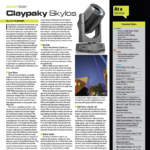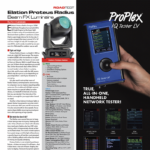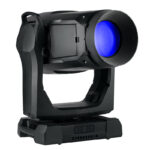LDI 2016 was populated by many memorable displays and booths, not the least eye-catching of which was a giant (playable) Rock ‘em Sock ‘em Robots display built by Blizzard Lighting and ModTruss. The Wisconsin-based company has been involved in the lighting industry since 2010, when they sold their first fixture, the Flurry.
Automated moving lights today tend heavily in the direction of moving head fixtures — scanners are a relative scarcity; a rare bird indeed. Nevertheless, they have a significant advantage in one area: pan and tilt speed. The top speed of a moving mirror with its negligible mass can be screaming in comparison to all but the fastest moving heads, though the trade-offs are pan and tilt range. Today, we’re looking at one of these not-often-seen moving mirror fixtures, the Blizzard TurboScan.
The TurboScan follows the general physical layout we’ve come to expect in moving-mirror fixtures, with a housing for the electronics and lighting effects in the bottom, and a half-enclosure near the top with the armature and motors for the mirror, and a lens underneath to direct the light onto the mirror. When shipped, there is a sturdy metal plate secured with thumbscrews over the mirror assembly to protect it during transit. There is a single bracket with tightening handles for attaching rigging hardware to, and the fixture can also sit on its base for floor applications.

Output and Dimming
The light source for this fixture is a 150-watt array of white LEDs in the “base” of the fixture. I measured 6,310 lux at five meters, after letting the fixture run at full power for 30 minutes. Thermal drop was small, only 3 percent. Blizzard’s cooling system is clearly effective at removing waste heat from this system and keeping the LED dies at a low and happy temperature. The beam angle is fixed at 15°
Dimming is completely electronic; there is no need for a mechanical dimmer with LEDs. The dimming was smooth throughout most of the range, with the curve being close to an ideal S-curve, though I found that the intensity drops to zero at around 6 percent on the dimmer. That said, the fixture interpolates the incoming data on blackouts, and the fade to black was smooth. Blizzard provides three dimmer curves for those who need other options. The LED optics in this light make for a very flat and even field, which lends itself well to aerial projections and effects. PWM frequency is 2,000Hz, which should be fast enough to avoid issues with cameras on stage.

Effects
Blizzard provides seven fixed color slots plus open for the color system. Some of these colors are quite saturated and have correspondingly low transmission rates, particularly the red. Phosphor-converted white LEDs like these don’t have a lot of red energy in the spectrum to begin with, so this is to be expected. Split colors are very usable with this system; the dichroic filters are close to each other with very small gaps in between them. Further, the order of the colors here makes a lot of sense, with adjacent colors making pleasing split color combinations. Filters are glued to the wheel, and are not user-replaceable.
There are two gobo wheels, both with seven positions plus open. The first has glass and steel gobos, which are indexable and rotatable, with smooth gobo rotation all the way down to the slowest speeds. Patterns on this wheel are mostly optimized for aerial projection, and there’s a good selection of both black and white and colored gobos. The second wheel is all steel gobos, and has breakups patterns suitable for projection onto scenery. Center-to-edge focus was good, with very acceptable levels of fuzzing toward the outside edges. It’s possible to put two gobos into the beam and do a focus pull or gobo morph between the two wheels, which provides some interesting effects. Changes between patterns were snappy, around one tenth of a second. The rotating gobos are all user-replaceable and use a standard carrier system, with a gobo carriage that pulls out and snaps back in.
The fixture includes an iris which is quite fast and works well with the prisms. The fixture includes an iris effects channel for pulses of varying speeds. One note about the prism — its position as one of the first things in the optical train places it just outside of the range where the user can get a perfect focus on it, but it’s very close.
The fixture includes two prisms and a frost flag, all of which occupy the same wheel and therefore cannot be overlaid. First in line is the eight-facet circular prism, followed by the three-faced circular prism, then finally the frost. These prisms are all indexable and rotatable and provide good image separation with minimal edge fall-off. The frost here is an interesting choice; it’s quite heavy, and while it provides a nice soft fall-off on the edges of the field, it also reduces the light output an appreciable amount. This is especially true when used in conjunction with some of the darker colors, something to be aware of while programming.
Pan and tilt ranges are 180° and 90°, respectively, and, as expected, the movement is extremely fast. A complete pan movement takes a scant 0.6 seconds, with a tilt movement taking 0.3 seconds. The mirror, like most other fixtures of this type, does not correct itself if it gets knocked out of place, so take care to mount where curious onlookers can’t touch. Pan and tilt movements exhibited some minor jitters on movements longer than ten seconds, but Blizzard provides a timing channel for use when programming very slow movements. When using the timing channel, take care to set the speed and movement channel fade timings to zero to avoid weird movements across the stage.

Control input is via 3 and 5-pin XLR DMX inputs, and the fixture takes from 21-24 DMX channels. Reset is somewhat badly behaved in that the unit begins outputting before the mirror has homed up fully, however, the delay between the LEDs coming on and the mirror reaching its final position is very short, less than a second. Power is via Seetronic PowerCON-compatible in and pass-throughs, and the fixture auto-ranges from 90-250VAC, and the unit draws 184 watts at full tilt. The menu on the rear provides information as well as DMX addressing functions and mode changes.
Ultimately, the Blizzard TurboScan brings to the table a set of features perfect for clubs, small stages, and houses of worship.
At a Glance
A Speedy, Compact Moving Light Solution
There are lots of reasons to choose a moving mirror light, especially when speed and size are critical factors. The small form factor should fit easily onto stages that have limited space, while the LED source is a cooler choice for situations and spaces that can’t tolerate a lot of excess heat. The speed of the mirror makes for dynamic movement effects, and the wide range of effects in this small package promise a great value for both size and money.
Blizzard Turbo Scan
PROS
Compact, fast, low power consumption
CONS
Heavy frost cuts out a lot of light; reset issues
FEATURES
- Light Source: 150W White LED
- Rated for: 60,000 hours of use
- Beam Angle: Fixed at 15°
- Pan: 180° (0.8 seconds max)
- Tilt: 90° (0.5 seconds max)
- Control: USITT DMX-512
- DMX Channels: 21/23/24
- Operating Modes: Standalone, M/S, Auto, Sound Active
- Control Panel: LCD, full-color, 4-button
- Gobos: Two gobo wheels w/7 gobos each
- Gobo Size/Image Size: 24.8mm/17.5mm
- Prism: 3- and 8-facet rotating, indexable prism
- Frost Filter
- Multi-mode iris
- Built-in programs & sound-active mode
- Connectivity: 3-pin/5-pin XLR male input, 3-pin/5-pin XLR female output connections
- Omega mounting brackets
- Two-year warranty
STATS [b/w box, include all]
Weight: 26.5 lbs.
Size: 10.3” x 8.7” x 20.9”
Wattage: 187 watts
MSRP: $1,899.99
More Info: www.blizzardlighting.com



